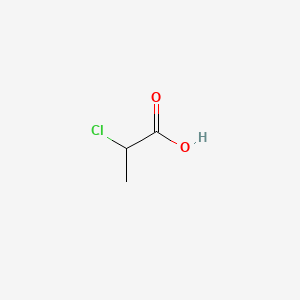D1369 | 2-chloroproprionate
| Target | Dose | Time | Species | Model | Method | Action | Positive criterion | Reference |
|---|---|---|---|---|---|---|---|---|
| [Pyruvate dehydrogenase (acetyl-transferring)] kinase isozyme 2, mitochondrial (EC 2.7.11.2) (Pyruvate dehydrogenase kinase isoform 2) (PDH kinase 2) (PDKII) | 255 | |||||||
| Pictogram | Signal | Statements | Precautionary Statement Codes |
|---|---|---|---|
  |
Danger |
H302: Harmful if swallowed [Warning Acute toxicity, oral] H314: Causes severe skin burns and eye damage [Danger Skin corrosion/irritation] |
P260, P264, P270, P280, P301+P312, P301+P330+P331, P303+P361+P353, P304+P340, P305+P351+P338, P310, P321, P330, P363, P405, and P501; (The corresponding statement to each P-code can be found at the GHS Classification page.) |
  |
Danger |
Aggregated GHS information provided by 87 companies from 4 notifications to the ECHA C&L Inventory. Each notification may be associated with multiple companies. H302 (100%): Harmful if swallowed [Warning Acute toxicity, oral] H314 (100%): Causes severe skin burns and eye damage [Danger Skin corrosion/irritation] Information may vary between notifications depending on impurities, additives, and other factors. The percentage value in parenthesis indicates the notified classification ratio from companies that provide hazard codes. Only hazard codes with percentage values above 10% are shown. |
P260, P264, P270, P280, P301+P312, P301+P330+P331, P303+P361+P353, P304+P340, P305+P351+P338, P310, P321, P330, P363, P405, and P501; (The corresponding statement to each P-code can be found at the GHS Classification page.) |
  |
Danger |
H302: Harmful if swallowed [Warning Acute toxicity, oral] H314: Causes severe skin burns and eye damage [Danger Skin corrosion/irritation] |
P260, P264, P270, P280, P301+P312, P301+P330+P331, P303+P361+P353, P304+P340, P305+P351+P338, P310, P321, P330, P363, P405, and P501; (The corresponding statement to each P-code can be found at the GHS Classification page.) |
    |
Danger |
H302: Harmful if swallowed [Warning Acute toxicity, oral] H310: Fatal in contact with skin [Danger Acute toxicity, dermal] H314: Causes severe skin burns and eye damage [Danger Skin corrosion/irritation] H318: Causes serious eye damage [Danger Serious eye damage/eye irritation] H331: Toxic if inhaled [Danger Acute toxicity, inhalation] H371: May cause damage to organs [Warning Specific target organ toxicity, single exposure] H373: Causes damage to organs through prolonged or repeated exposure [Warning Specific target organ toxicity, repeated exposure] |
P260, P261, P262, P264, P270, P271, P280, P301+P312, P301+P330+P331, P302+P350, P303+P361+P353, P304+P340, P305+P351+P338, P309+P311, P310, P311, P314, P321, P322, P330, P361, P363, P403+P233, P405, and P501; (The corresponding statement to each P-code can be found at the GHS Classification page.) |
| 2-chloropropanoic acid |
| CAS Number | 16987-02-3, 28554-00-9, 29617-66-1, 598-78-7, 62138-52-7, 7474-05-7 |
| PubChem Compound | 11734 |

